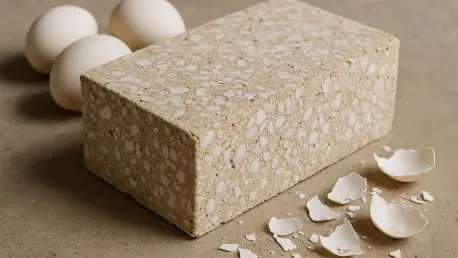Imagine a world where the millions of tons of eggshell waste discarded annually are not just trash, but a cornerstone of sustainable architecture, transforming how we think about construction. Every year, vast amounts of eggshells end up in landfills, contributing to methane emissions, while the construction industry continues to be a major source of carbon dioxide pollution. A groundbreaking project from South Korea, known as Re:Shell, offers a visionary solution by transforming this overlooked waste into a viable building material. This innovation could potentially address two pressing environmental challenges at once: reducing landfill waste and curbing the pollution caused by traditional construction practices like concrete production. By reimagining how buildings are constructed and what happens to them after their useful life, this development sparks curiosity about whether everyday waste could redefine the future of eco-friendly design. The implications of such a shift are profound, promising a new era where sustainability and practicality converge in unexpected ways.
Environmental Challenges in Construction and Waste Management
The Burden of Concrete and Eggshell Waste
The construction industry stands as a significant contributor to global environmental degradation, with concrete production alone accounting for roughly 8% of worldwide carbon dioxide emissions, according to data from Princeton University. This staggering figure highlights the urgent need for alternatives that can lessen the sector’s ecological footprint. Simultaneously, eggshell waste poses a lesser-known but equally troubling issue. With annual global production estimated between 7.2 and 10 million tons, as reported by the U.S. Environmental Protection Agency and other research sources, discarded eggshells in landfills release methane, a greenhouse gas far more potent than carbon dioxide. The dual challenge of mitigating construction-related pollution and managing organic waste streams like eggshells has pushed innovators to seek solutions that address both problems in tandem. Re:Shell’s approach, which repurposes eggshell waste into building materials, emerges as a promising strategy to tackle these intertwined issues, potentially reducing landfill contributions while offering a cleaner substitute for concrete.
Global Implications of Unsustainable Practices
Beyond the immediate environmental impact, the long-term consequences of current construction and waste management practices are alarming. In South Korea, for instance, aging infrastructure from decades past generates substantial demolition debris, accounting for nearly 45% of the nation’s total waste, as noted in industry reports. This statistic underscores a broader global trend where traditional building materials, designed for permanence, often become burdensome waste at the end of their lifecycle. The accumulation of such debris, coupled with the ongoing emissions from concrete manufacturing, exacerbates climate change challenges. Eggshell waste, often overlooked, adds another layer of complexity by contributing to greenhouse gas emissions in landfills. Addressing these systemic issues requires a paradigm shift toward materials that not only serve functional purposes but also minimize long-term ecological harm. Initiatives like Re:Shell signal a move toward circular economy principles, where waste is redefined as a resource, offering hope for a more balanced approach to building and disposal practices worldwide.
Innovations in Sustainable Building Materials
Re:Shell’s Eggshell-Based Material Breakthrough
At the heart of Re:Shell’s innovation lies a meticulous process that transforms eggshell waste into a sustainable construction material. The method involves cleaning, drying, and grinding eggshells into a fine powder, which is then combined with natural elements like clay, wheat bran, and straw. This mixture results in a lightweight, breathable, and durable substance, with calcium carbonate—a key component in eggshells—acting as a natural binding agent akin to those found in concrete. The modular bricks produced from this material can be used to construct walls and even furniture without the need for adhesives, allowing for easy disassembly and reformation as required. Testing has shown that the material possesses impressive sturdiness while maintaining an eco-friendly edge: it is biodegradable, designed to break down in soil over time. This characteristic aligns with Re:Shell’s vision of creating structures that fulfill their purpose and then return to the earth, challenging the conventional emphasis on permanence in architecture with a focus on transient utility.
Broader Trends in Eco-Friendly Construction
Re:Shell’s work does not stand alone but is part of a growing wave of experimentation with alternative construction materials aimed at reducing environmental impact. Concepts like fungal networks for building frameworks and self-repairing substances are gaining traction as researchers and designers explore ways to minimize the construction industry’s carbon footprint. While detailed data on the outdoor durability of Re:Shell’s eggshell-based material remains limited, initial reports suggest potential applications for external facades, hinting at versatility beyond indoor use. This aligns with a broader industry shift toward sustainability, where the goal is not just to build structures that last indefinitely but to create systems that integrate seamlessly with natural cycles. The emphasis on biodegradability over enduring strength, as championed by thinkers like designer Anna Lazzaron, reflects a rethinking of durability itself. Such innovations collectively point to a future where building materials are chosen not only for their immediate functionality but also for their long-term environmental harmony.
Shaping a Sustainable Architectural Future
Looking ahead, the implications of projects like Re:Shell extend far beyond individual applications, potentially reshaping architectural practices on a global scale. The focus on circular design—where materials are reused, repurposed, or allowed to decompose naturally—offers a counterpoint to the linear “build and discard” model that dominates today. By leveraging eggshell waste, an abundant and often discarded resource, this initiative demonstrates how seemingly mundane byproducts can become valuable assets in addressing climate challenges. If commercialized successfully, such materials could reduce reliance on high-emission products like concrete while curbing landfill waste. The diversity of emerging solutions, from eggshell bricks to other bio-based alternatives, underscores a collective push toward sustainability in construction. This movement invites a reevaluation of how buildings are designed, urging architects and builders to prioritize ecological balance alongside structural integrity, paving the way for environments that serve humanity without burdening the planet.









